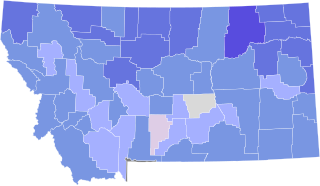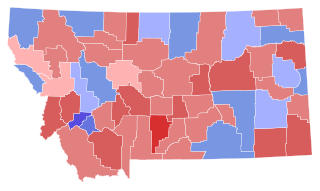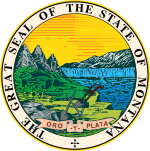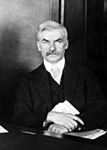
The 1978 United States Senate elections were held on November 7, in the middle of Democratic President Jimmy Carter's term. The 33 seats of Class 2 were contested in regular elections. Special elections were also held to fill vacancies.

The 1970 United States Senate elections was an election for the United States Senate. It took place on November 3, with the 33 seats of Class 1 contested in regular elections. Special elections were also held to fill vacancies. These races occurred in the middle of Richard Nixon's first term as president. The Democrats lost a net of three seats, while the Republicans and the Conservative Party of New York picked up one net seat each, and former Democrat Harry F. Byrd Jr. was re-elected as an independent.

The 1964 United States Senate elections were held on November 3. The 33 seats of Class 1 were contested in regular elections. Special elections were also held to fill vacancies. They coincided with the election of President Lyndon B. Johnson by an overwhelming majority, to a full term. His Democratic Party picked up a net two seats from the Republicans. As of 2023, this was the last time either party has had a two-thirds majority in the Senate, which allowed the Senate Democrats to override a veto, propose constitutional amendments, or convict and expel certain officials without any votes from Senate Republicans. However, internal divisions would have prevented the Democrats from having done so. The Senate election cycle coincided with Democratic gains in the House in the same year.

Thomas James Walsh was an American lawyer and Democratic Party politician from Helena, Montana who represented Montana in the US Senate from 1913 to 1933. He was initially elected by the state legislature, and from 1918 on by popular vote, in keeping with the requirements of the Seventeenth Amendment to the United States Constitution.

The 1912–13 United States Senate elections were held on various dates in various states. They were the last U.S. Senate elections before the ratification of the Seventeenth Amendment in 1913, establishing direct elections for all Senate seats. Senators had been primarily chosen by state legislatures. Senators were elected over a wide range of time throughout 1912 and 1913, and a seat may have been filled months late or remained vacant due to legislative deadlock. Some states elected their senators directly even before passage of Seventeenth Amendment. Oregon pioneered direct election and experimented with different measures over several years until it succeeded in 1907. Soon after, Nebraska followed suit and laid the foundation for other states to adopt measures reflecting the people's will. By 1912, as many as 29 states elected senators either as nominees of their party's primary or in conjunction with a general election.

The 2014 United States Senate elections were held on November 4, 2014. A total of 36 seats in the 100-member U.S. Senate were contested. Thirty-three Class 2 seats were contested for regular six-year terms to be served from January 3, 2015, to January 3, 2021, and three Class 3 seats were contested in special elections due to Senate vacancies. The elections marked 100 years of direct elections of U.S. senators. Going into the elections, 21 of the contested seats were held by the Democratic Party, while 15 were held by the Republican Party.

The 1992 United States Senate election in Illinois was held on November 3, 1992. Incumbent Senator Alan J. Dixon decided to run for re-election a third term, but he was defeated in the Democratic primary by Carol Moseley Braun, who won the general election. Until 2022, this was the last time a single party won Illinois's Class 3 Senate seat in two or more consecutive elections.

The 2014 United States Senate election in Montana took place on November 4, 2014, to elect a member of the United States Senate from Montana, concurrently with other elections to the United States Senate in other states and elections to the United States House of Representatives and various state and local elections.

The 1918 United States Senate election in Montana took place on November 5, 1918. Incumbent United States Senator Thomas J. Walsh, who was first elected to the Senate in 1912, ran for re-election. He won the Democratic primary uncontested, and was opposed in the general election by Oscar M. Lanstrum, a former State Representative and the Republican nominee, and Jeannette Rankin, one of two United States representatives from Montana's at-large congressional district and the nominee of the National Party. Walsh narrowly won his second term in the Senate.

The Ohio general elections, 2014 were held on November 4, 2014, throughout Ohio, with polls opened between 6:30AM and 7:30PM. The close of registration for electors in the primary election was April 7, 2014, and the primary election day took place on May 6, 2014.

The 1924 United States Senate election in Montana took place on November 4, 1924. Incumbent United States Senator Thomas J. Walsh, who was first elected to the Senate in 1912 by the state legislature, and re-elected in 1918 by popular vote, ran for re-election. He was unopposed in the Democratic primary.

The 1930 United States Senate election in Montana took place on November 3, 1936. Incumbent United States Senator James E. Murray, who was first elected to the Senate in a special election in 1934, ran for re-election. He narrowly emerged from a competitive and close Democratic primary, wherein he was challenged by United States Congressman Joseph P. Monaghan, who represented Montana's 1st congressional district. In the general election, Murray was opposed by Thomas O. Larson, a State Senator and the Republican nominee, and Monaghan, who, after losing the primary, ran as an independent candidate. Murray ended up winning a second term, and his first full term, in a landslide, defeating both of his opponents by a comfortable margin.

The 1946 United States Senate election in Montana took place on November 5, 1946. Incumbent United States Senator Burton K. Wheeler, who was first elected to the Senate in 1922, and was re-elected in 1928, 1934, and 1940, ran for re-election. He was challenged in the Democratic primary by Leif Erickson, the Chief Justice of the Montana Supreme Court, and, following a close election, was narrowly defeated by Erickson. In the general election, Erickson faced State Senator Zales Ecton, the Republican nominee. Ultimately, Ecton defeated Erickson by a fairly wide margin, winning his first and only term in the Senate. Another Republican would not be elected Senator from Montana until 42 years later, when Conrad Burns narrowly won the 1988 election.

The 1988 Montana gubernatorial election took place on November 8, 1988. Incumbent Governor of Montana Ted Schwinden, who was first elected in 1980 and was re-elected in 1984, declined to seek re-election to a third term, creating an open seat. Stan Stephens, the former president of the Montana Senate, won a close Republican primary, and advanced to the general election, where he was opposed by Thomas Lee Judge, Schwinden's predecessor as governor and the Democratic nominee. Though the general election was hotly contested, Stephens ultimately defeated Judge, becoming the first Republican to win a gubernatorial election in Montana since 1964.

The 1928 Montana gubernatorial election took place on November 6, 1928. Incumbent Governor of Montana John E. Erickson, who was first elected governor in 1924, ran for re-election. Erickson only narrowly won the Democratic primary against future Governor Roy E. Ayers, and advanced to the general election, where he was opposed by U.S. Attorney Wellington D. Rankin, the former Attorney General of Montana. Although Herbert Hoover carried the state in a landslide in the presidential election that year, Erickson won re-election to his second term as governor in a landslide over Rankin.

The 1916 Montana gubernatorial election took place on November 7, 1916. Incumbent Governor of Montana Sam V. Stewart, who was first elected governor in 1912, ran for re-election. After comfortably winning the Democratic primary, he advanced to the general election, where he faced Frank J. Edwards, the former Mayor of Helena, who narrowly emerged victorious in a close Republican primary. Benefitting from then-President Woodrow Wilson's landslide victory in Montana in the presidential election that year, Stewart narrowly won re-election to his second and final term as governor.
Albert John Galen was the Montana Attorney General from 1905 to 1913, and a justice of the Montana Supreme Court from 1921 to 1933.
The 1946 Massachusetts general election was held on November 5, 1946, throughout Massachusetts. Primary elections took place on June 18.

The 2020 Ohio general elections were held on November 3, 2020 throughout the US state of Ohio. The office of the Ohio Secretary of State oversees the election process, including voting and vote counting.

The 2022 Texas elections were held on November 8, 2022. Primary elections were held on March 1, with runoffs held on May 24 for primary candidates who did not receive a majority of the vote.



















